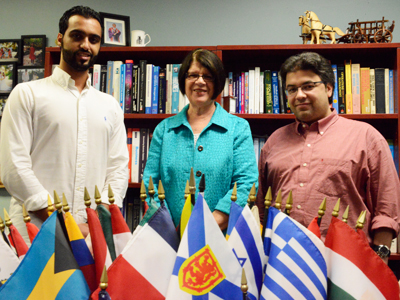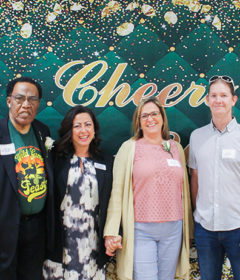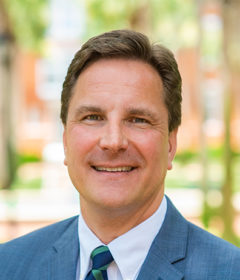Culture, learning merge in statistics class
 When Betty Thorne, Ph.D., professor of statistics, (center in photo) first envisioned the idea of integrating foreign cultures into her business statistics class, even she wondered how that might be accomplished.
When Betty Thorne, Ph.D., professor of statistics, (center in photo) first envisioned the idea of integrating foreign cultures into her business statistics class, even she wondered how that might be accomplished.
“I asked myself, ‘How can I do that with statistics? How can I give the students the experience of watching a business presentation in another language and having it make sense to those who speak only English?’” she wondered.
What transpired was a combination of excellent statistical analysis and a classroom of engaged fellow students who enjoyed a unique and well developed presentation – in Arabic.
Thorne, who is clearly passionate about her students and work, and her husband frequently travel to Romania, the land of her ancestry, on missionary trips where their lessons are translated from English into Romanian. She wanted to give her students a similar cultural experience, especially those who had not traveled outside the United States.
The final assignment in her business statistics class was to develop a presentation by selecting a company and sharing its history, size, founders, products, mission, values, vision, financials and growth. Students were to develop data and choose five statistical procedures they learned during the semester and integrate it with their chosen company, acting as a statistical consultant to solve company problems.
The cultural part of the experience happened when Thorne asked two students — Abdullah Alghamdi (on left in photo) and Ahmad Altuhami (on right in photo) from Saudi Arabia – to do their presentation in Arabic, translating into English.
The results were well beyond Thorne’s expectations.
Alghamdi and Altuhami chose the company known as Al Baik, the equivalent of a U.S. fast-food restaurant, which serves chicken and shrimp dishes. Its founder had died of cancer at 48 and his two sons continued the business.
“We chose this company because it is extremely well known and is highly effective in how it serves its customers,” said Altuhami. “Located primarily in the western part of Saudi Arabia, many friends will always ask me to bring them food from Al Baik if they live too far from one of their restaurants.”
To begin the presentation, Altuhami talked through a few slides in Arabic and Alghamdi translated into English, then they switched, moving back and forth throughout the presentation. Afterwards, they injected a bit of Saudi Arabian hospitality into the moment with Arabic coffee and dates.
“It is a sign of respect and hospitality to offer coffee and dates when a visitor comes to our home,” said Alghamdi.
“It was an amazing presentation and I was so proud of them,” said Thorne who was extremely pleased with the results. “It was obvious they put a lot of work and thought into the project.” Thorne was especially pleased at how the experience bonded the class and helped everyone see another side of the world.
The presentation also was attended by Eric Canny, executive director of International Learning, and two of his colleagues from WORLD: International Learning, a department at Stetson whose mission is to promote international issues into the curriculum, support international students on campus, and assist students who wish to study abroad.
by Mary M. McCambridge



